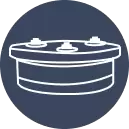Well equipment includes all components and accessories required to keep a water well system fully operational and safe beyond the pump itself. This group includes those devices controlling pump operation, managing water pressure, storing the water under air pressure, and sealing the well against contamination. Quality components also provide reliable water delivery while containing energy costs, minimizing maintenance and protecting water quality over the life of the system.
Control Switches
Control switches work as an automatic plug or unplug for the pump. They sense either the level of water or other conditions, then start the pump when more water is needed and stop it when the tank is full.
Common Types
- Float operated switches use a buoyant float submerged in a tank or reservoir. When the water falls, the float falls, which turns on the pump; when the water rises, the float closes the switch.
Key Benefits
- Pumps operate only on demand, reducing electricity consumption.
- Built-in protections like dry-run and overload help prevent damage.
- Some switches extend alarms or fault signals to alert users to a problem before systems fail.
Pressure Switches
Pressure switches sense the system pressure and turn the pump on and off depending on those set points. The pump turns on when tank pressure reaches the “cut-in” setting. At the “cut‑out” setting, the pump shuts off.
Mechanical vs. Electronic
- A mechanical switch consists of a spring and a piston. They are straightforward to use, reliable and economical, but can go out of adjustment from time to time.
- Electronic switches have a pressure sensor and solid‑state electronics for more accuracy and longer service life. They often fit seamlessly into digital monitoring systems.
How to Choose the Right Pressure Switch
- Plumbing pressure: The average home systems generally come with a 30–50 psi Cut-in and 50–70 psi Cut-out. Higher ranges may be needed for commercial setups.
- Differential Adjustment: The distance between cut‑in and cut‑out pressures can often be adjusted to reflect patterns of water usage.
- Fittings & Ratings: Ensure that the switch’s pipe connection size (e.g., ¼″ or ½″ NPT), voltage and horsepower ratings correspond with the pump.
Pressure Tanks
Pressure tanks provide a reserve of water maintained under air pressure. Instead, the cushion allows small portions of water to flow without activating the pump each time, leading to fewer pump starts and increased lifespan.
Main Tank Types
- Bladder tanks have an internal bladder that separates air from water. It prevents waterlogging and keeps the pressure equal.
- Bladder tanks use a bladder; diaphragm tanks use a solid diaphragm. They provide comparable advantages at a generally lower cost.
- Above the water, solid steel tanks keep a constant air charge. They do the job but require regular air‑charge checks to avoid waterlogging.
Sizing & Installation Tips
- Size the tank to the actual water usage. A bigger tank means fewer pump cycles for the same draw.
- Charged the tank’s air pre‑charge to approximately 2 psi under the pump’s cut‑in pressure.
- Tanks should be installed in a safe site (no freezing) and as close to the pressure switch as possible to minimize the loss of pressure.
Well Caps & Seals
A properly constructed well cap and well seal can keep out dirt, insects and surface water, which protects the quality of the groundwater and meets health regulations.
Cap Styles
- Sanitary caps include a screened vent, which allows air to escape, to avoid any problems with pressure building and lets pests and debris out.
- Locking caps secure it against theft.
- Non-vented caps seal the well entirely and are used in situations where venting is done elsewhere.
Sealing Accessories
- Grommets & O‑Rings create compact seals between the lid and housing.
- Locking Rings and Bolts lock caps into position.
- Cement seals are used to permanently close abandoned wells or special installations.
Integrating Well Equipment
For the best performance, select components that function together:
- Pressure Settings: Ensure the control switch, pressure switch, and tank pre‑charge are matched for smooth cycling of the pump.
- Materials: Where corrosion is a concern, use brass or stainless‑steel fittings. Plastics, such as CPVC or polyethylene, perform adequately in groundwater in the majority of scenarios.
- Automation Options: Electronic switches can connect to controllers for remote monitoring, automatic backflush, or smart building‑management systems.
Installation & Maintenance Best Practices
With proper care, a well system can operate reliably and efficiently for years to come:
- Annual Checks: Test the operation of the pressure switch, inspect electrical contacts, and verify the tank air pre-charge.
- Pump Cycling Monitoring: If pumping starts increase per hour, it can indicate waterlogging, tank undersizing, or leaks.
- Winter Protection: In frigid areas, wrap or heat-tape exposed piping, switches and tanks to avoid freeze damage.
- Record Keeping: Keep logs of installation dates, model numbers, service events, and pressure settings. A comprehensive record makes troubleshooting, warranty filing, and future expansion easier.
Benefits of Quality Well Equipment
Investing in reliable control switches, pressure switches, tanks, and seals pays off in the following ways:
- Energy Efficiency: Pumps only run when necessary, which reduces electricity costs.
- Equipment Protection: Prevents dry runs, decreases cycling, and prolongs pump and motor life.
- Consistent Water Delivery: Constant pressure ensures faucets and fixtures deliver and perform as expected.
- Water Safety: Proper seals and caps prevent contamination from reaching the well.
Conclusion
Well control switches, pressure switches, pressure tanks, and sanitary seals of the complete well equipment package are selected and installed to function together specifically. By understanding the role of each component and following best practices for sizing, installation, and maintenance, any well system can provide an uninterrupted, reliable water supply with the least possible energy use.
Quality equipment not only protects pumps and piping but also preserves water purity and operational efficiency for years. Making sure to have good parts and maintaining them means a well-maintained system will be a key asset and not a constant source of headaches.



